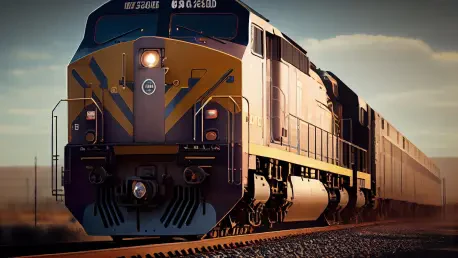Imagine a logistics landscape where rail freight terminals operate with the precision of a well-oiled machine, slashing delays and boosting capacity in a sector often outpaced by road transport. This scenario is becoming a reality in Germany, where digital innovation is tackling longstanding inefficiencies at intermodal freight terminals—critical junctures where road and rail intersect. At the forefront of this transformation is Hitachi Rail’s cutting-edge digital solution, InGa-Z, developed in collaboration with Protostellar GmbH and supported by industry giants like DB Cargo AG. This review delves into the features, performance, and real-world impact of this technology, assessing its role in reshaping rail freight competitiveness.
Key Features of the InGa-Z Digital Solution
Cloud-Based Terminal Operating System
The backbone of the InGa-Z system is its cloud-based Terminal Operating System, a platform designed to streamline operations at intermodal freight terminals. This technology automates critical processes such as container tracking and order management, ensuring real-time data accessibility for all stakeholders, including freight forwarders and rail operators. By centralizing information in the cloud, the system eliminates silos, fostering smoother coordination across the supply chain.
Beyond automation, the platform integrates mobile applications that allow terminal staff to update and monitor activities on the go. This flexibility reduces downtime and enhances responsiveness to operational hiccups. The result is a marked improvement in terminal efficiency, setting a new standard for how digital tools can optimize logistics at critical transport hubs.
AI-Driven Load Optimization and Contactless Check-In
Another standout feature of InGa-Z is its use of artificial intelligence to optimize train loading, ensuring maximum capacity utilization with minimal manual intervention. The AI algorithms analyze container dimensions, weight, and destination data to arrange loads efficiently, allowing terminals to handle an additional loading unit per train. This capability directly translates to higher throughput and cost savings for rail operators.
Equally impressive is the contactless check-in functionality, which leverages digital interfaces to expedite the arrival and departure of trucks at terminals. Drivers can complete check-in procedures via mobile apps, bypassing traditional paperwork and reducing wait times significantly. Combined, these features minimize human error and operational delays, offering a glimpse into the future of frictionless freight processing.
Performance and Real-World Impact
Since its deployment at the Philippsthal Terminal in Germany, the InGa-Z system has delivered measurable improvements that underscore its transformative potential. Check-in times at the terminal have been cut by 50%, allowing for faster turnaround of vehicles and reducing congestion at entry points. Additionally, manual data entry has dropped by 70%, freeing up staff to focus on higher-value tasks and reducing the likelihood of errors.
The financial implications of these gains are substantial, with the system’s ability to accommodate an extra loading unit per train projecting annual revenue increases of over €25 million for the rail freight sector. These outcomes highlight how digital tools can enhance rail’s competitiveness against road haulage, a mode that has long dominated due to its flexibility and speed. InGa-Z proves that rail can close this gap with the right technological support.
Moreover, the system’s impact extends beyond numbers, influencing perceptions within the industry. Stakeholders, including leaders from DB Cargo AG, have noted that such innovations remove traditional barriers, making rail a more viable option for freight transport. This shift in mindset is critical for driving broader adoption of digital solutions across the sector.
Industry Trends and Developments
The emergence of InGa-Z aligns with a broader industry trend toward integrating digital tools to address inefficiencies in intermodal freight transport. Across Germany and Europe, logistics providers are increasingly adopting data-driven systems to enhance connectivity between transport modes, ensuring seamless transitions from road to rail. This movement reflects a growing recognition that technology is essential for modernizing logistics infrastructure.
Emerging innovations, such as advanced analytics and Internet of Things integration, are complementing solutions like InGa-Z by providing deeper insights into supply chain dynamics. These tools enable predictive maintenance of equipment and real-time tracking of shipments, further reducing operational risks. Over the next few years, from 2025 to 2027, the industry is expected to see even greater investment in such technologies as regulatory bodies and private entities align on the need for digital transformation.
Challenges in Adoption and Scalability
Despite its successes, the rollout of digital solutions like InGa-Z faces significant hurdles that could temper widespread adoption. Technical integration remains a challenge, as many terminals operate on legacy systems incompatible with modern cloud-based platforms. Bridging this gap requires substantial investment and expertise, which may deter smaller operators from embracing the technology.
Regulatory constraints also pose obstacles, with varying standards across regions complicating the deployment of uniform digital systems. Compliance with data privacy and security requirements adds another layer of complexity, necessitating robust safeguards within the InGa-Z framework. Addressing these issues will be crucial for ensuring the solution’s scalability beyond pilot sites.
Market adoption barriers further compound the challenge, as skepticism about the return on investment persists among some industry players. Overcoming this resistance demands clear communication of the system’s benefits, backed by data from successful implementations. Collaborative efforts between technology providers and terminal operators will be key to building trust and driving uptake.
Future Prospects for Rail Freight Digitization
Looking ahead, the trajectory of intermodal freight digitization appears promising, with systems like InGa-Z poised to evolve alongside emerging technologies. Innovations such as machine learning and blockchain could enhance the platform’s capabilities, offering even greater transparency and security in freight operations. These advancements may redefine how terminals manage complex logistics networks in the coming years.
The long-term impact of such technologies extends to sustainability, a pressing concern for the transport sector. By optimizing load efficiency and reducing idle times, digital solutions can lower carbon emissions, aligning rail freight with global environmental goals. This dual focus on efficiency and eco-friendliness positions rail as a cornerstone of sustainable logistics in Germany and beyond.
Furthermore, government support, such as through programs like the Federal Future of Rail Freight Transport initiative, will likely accelerate the adoption of digital tools. As policies evolve to incentivize innovation, the rail freight ecosystem could see a surge in interconnected, technology-driven terminals. This vision of a fully digitized network offers a compelling blueprint for the industry’s future.
Final Thoughts and Next Steps
Reflecting on the evaluation, it is evident that Hitachi Rail’s InGa-Z system marks a significant leap forward in addressing inefficiencies at intermodal freight terminals. Its deployment at the Philippsthal Terminal showcased remarkable gains in speed and accuracy, setting a benchmark for what digital innovation can achieve in rail logistics. The technology proves that rail can compete with road transport when equipped with the right tools.
Moving forward, the focus should shift to tackling integration challenges by developing standardized protocols that ease the transition for terminals with outdated infrastructure. Industry leaders and policymakers must collaborate to streamline regulatory frameworks, ensuring that solutions like InGa-Z can scale without bureaucratic delays. Investing in training programs for terminal staff will also be essential to maximize the system’s benefits.
Ultimately, the path ahead lies in fostering a culture of innovation within the rail freight sector, encouraging stakeholders to embrace digital transformation as a strategic imperative. By building on the foundation laid by InGa-Z, the industry can work toward a more connected, efficient, and sustainable logistics network, ensuring rail’s relevance in an increasingly competitive market.









